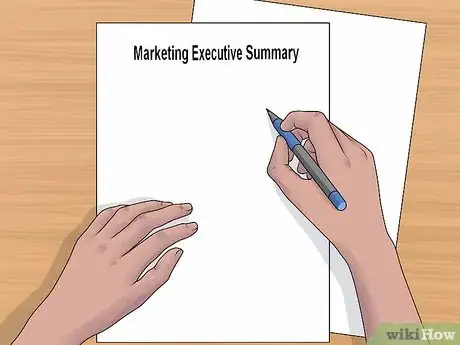This article was co-authored by Michelle Arbeau. Michelle Arbeau is a Numerologist & Life Strategist, and the CEO of Authentic You Media and Eleven Eleven Productions. She’s based in West Hollywood, California. With over 20 years of experience, she specializes in numerology, mediumship, and business advice. In 2015, Best Businesses named her the Best of West Hollywood Celebrity Numerologist, and she’s been hailed as the #1 Numerologist in the World and the #1 Celebrity Numerologist.
There are 10 references cited in this article, which can be found at the bottom of the page.
This article has been viewed 295,244 times.
Your business may spend a large amount of time and money on marketing. A smart business owner needs to assess how well their marketing plans are working. Specifically, your marketing efforts should get the attention of prospects. Eventually, a percentage of those prospects should become clients. You can perform market research to ask your clients about the effectiveness of your marketing message. Companies summarize the results of their research in a marketing report. Use the results of the report to make improvements in your business.
Steps
Evaluating Your Marketing Efforts
-
1Consider why you should perform market research and write a report. What information is important to you? What will you do with the marketing report after it is created? This process requires an investment of time and expense. Make sure that you have a clear plan for using the information that you collect.[1]
- Market research is the process of evaluating how well your marketing efforts are working. Specifically, does your marketing get the attention and interest of prospects? Are you converting enough of those prospects into clients?
-
2Identify your customer. Before you can identify your customer's need or problem, you must identify your target or typical customer. Your target audience is the specific customer profile you are trying to reach. This could be people of a certain gender, age, profession, interest set, group, or any other quality that you think makes a customer want to buy your product. In other words, these are the people who are most likely to buy your product and the people that you tailor your marketing to.[2]
- The more specific you can be about the identity of your customer, the better you can address their needs. Ask yourself, "Who am I targeting with this product?" and "What do they want?"
- Look at your current customers. What's the average age? Gender? Education level? Personality? Lifestyle? Hobby? Occupation? Marriage status? Values?[3]
- It is also important to know where your customers are coming from. Sources include search engines, social media, backlinks, referral traffic, and subscriber lists.
Advertisement -
3Evaluate your customer’s problem. Consumers buy products to solve a specific problem. Your customers will only buy when they feel that solving the problem is urgent.[4]
- For example, based on customer surveys and your industry knowledge, you uncover a customer problem. In this case, customers are losing time working or studying when their cell phone dies. If they forget their charger, they may lose hours of productivity.
-
4Detail your solution to the customer's problem. Think about how exactly you went about responding to the customer's problem. Why did you solve it that way? What make you think about the problem in this way? What exactly does your product or solution do or include?
- For example, to solve the problem of dying cell phones, you create a phone charger built into a backpack. Your customers use backpacks to store computers and other work or school items. As a result, the worker or student can always charge their phone.
-
5Determine how well your product solves your customer's problem. Figure out whether or not your product has reduced the impact of the problem you saw. This is also a good place to determine whether or not your problem needed solving in the first place. If sales are consistently low, this may be a sign that your solution was unnecessary.
- Over time, more customers buy your backpack and like using the built-in phone charger. These clients also believe that your product is different and better than competing products. You are building brand equity with your customers. To find out more about brand equity, see how to build brand equity.
-
6Identify your competitive advantage. Examine your competitors' products and how the solutions that they provide differ from your solution. In other words, look at what your product is able to provide to customers that your competitors' products cannot. What makes your product unique and better? The goal here is to identify a competitive advantage and focus on that advantage with marketing efforts. If this advantage can be sustained, it will lead to higher sales and greater customer retention.[5]
-
7Examine how you currently market your product. The idea of market research is to understand how you market now and how well clients respond. Analyze the steps you currently take to market your product.[6] For example, if you market your product online, you may be using some of the following strategies:
- You continually add blog posts, articles and other content to your website. Adding content drives traffic to your site. Your content also keeps a percentage of your audience coming back for new content.
- Your site offers an opt-in button for readers to subscribe to additional content that is emailed to them. This group gets a weekly email from you with new content links.
- You have an attractive home page that includes a picture of someone using your backpack phone charger. The site allows the user to easily navigate to your content page and to web pages with product information.
- You provide an e-commerce option for customers. Clients can buy your product online and receive their backpack in just 2-3 business days.
- This should also include information about the sales channels used, like online, bricks & mortar, types of retailers, etc. Analyze how well your product is doing in each of these channels.
-
8Evaluate the effectiveness of your marketing. Is marketing doing a good job of getting your product information to potential customers? If you are using blog posts or articles, are they actually being read? Determine if your marketing efforts are actually leading to traffic to your website and then if this traffic is converting into sales. If not, you may want to include ideas for a revised marketing strategy in your marketing report.
- Note your market share compared to competitors and market share trends. Are you gaining market share, losing it, or holding your own?
- For more on market share, see how to calculate market share.
- Keeping a close eye on your ROI is essential in order to stay abreast of how much you’re spending on marketing versus your return on that investment. Comparing what you’re spending on marketing versus your return on that investment is paramount to a good report.
-
9Summarize your findings for your marketing report. The results of your market research should be compiled and detailed in a market report. A market report includes a 1-2 page executive summary and a longer detailed report section.
- Your report should include such items as definition of the market size, competitors and their marketing size, as well as estimates of market share.
- You can use the market report to make changes to your marketing process. These changes can help you get more business from the time and money you spend on marketing.
Writing Your Executive Summary
-
1Think about the purpose of an executive summary. You need to provide a one page, or at most two page, summary of the results of your marketing research. Be sure to hit all of the major points of the rest of your report in this summary. Many people will read the summary first, to get a quick overview of your results.[7]
- The summary should include specific, numeric details from the rest of your report. These details should be condensed into bullet points and made prominent on the report.[8]
-
2Describe your company. The summary should provide a basic account of what your company does, where it is located, what type of employees (if any) you have, and any other organizational details. Also describe your products and goals for your future products or sales.
- For example, if your backpack charging company had plans to expand into purse chargers or another similar product line, include these plans in your summary.
- This should also include the sales channels being used by your business, as well as competitors and their sales channels. Are you different? Why? If not, do you have a competitive advantage that can be exploited in your marketing and sales efforts?
-
3Detail the objective of your research. Your report should specify what exactly you were trying to determine in your marketing research. This could be whether or not your marketing was effective in content, whether or not it reached the right audience, whether or not it properly informed customers about your product, or any other determination you wished to make.
-
4Evaluate how well you are reaching your intended audience. Typically, the objective of your market research is to assess how well you are convincing people in your target audience to buy your product. You need to be making sure that you're reaching an audience that will actually be purchasing your product. If you're not doing so, explain why you think this is the case and offer suggestions for different courses of action.
- For example, you could be examining how well advertisements for your backpack are reaching college students, as they would be a likely audience for your product. If your ads are primarily reaching adults, who don't generally carry backpacks, this would be an issue to raise in your evaluation.
-
5Display marketing conversion data. This figure represents how many potential customers or visitors to your website actually purchased a product. This can be evaluated with site traffic counters. If this number is particularly low, you should offer explanations as to why this might be the case and how you can improve on it.
- For example, if only 1 in 20 of your site's visitors actually buy one of your backpacks, you may want to reconsider the design of your websites, the ease of purchase, or the price of your product.
-
6Admit any data collection difficulties or incomplete sections. Your executive summary should also include a section where you explain whether or not you had any difficulty attaining the data within. This could help explain incomplete or omitted sections or topics. Sometimes, there's no way to obtain a certain set of data reliably. If this is the case, explain why it is so in your summary.
Completing Your Marketing Report
-
1Forecast future trends. Rather than just analyzing the effectiveness of past marketing techniques, you should also look at how effective these campaigns will be in the future. Explain any factors that you think might come into play. This can include more people coming online, more traffic coming to links to your website, or any other trends that you think might help or hurt your marketing techniques.
- You should also consider the fact that other competitors will arise if you are successful. Significant returns attract more competition, so if you don't have direct competitors now, rest assured that you will in the future. Have a plan in place to sustain your competitive advantage in spite of new entrants to the market.
- For example, perhaps you perceive that college students may be carrying backpacks less often as they switch to an all-digital education. You could remark on how this will hurt your business and explain how you will respond to it.
-
2Calculate marketing return on investment. It's also important to know if the money you're spending on advertising is increasing your revenue enough to make it worth it. Simply total your expenditures on certain marketing campaigns and compare that to how much your sales have (or have not) increased in the time since beginning those campaigns. Keep in mind that there may be a significant delay between implementing your marketing campaign and the resulting bump in sales. Consider the value you are getting for spending your money on advertising.
-
3Conduct surveys and compile the results. You can conduct surveys on your website or by using an email marketing campaign. You can also get information from focus groups. Your focus group should include people in your target audience.[9]
- To get the most out of your focus group, carefully plan the exact series of questions you want to ask. Your marketing report should include the questions you ask and why those questions are important to you.
- In your survey or focus group, ask people how they first heard about your product. If you’re the backpack company, you might determine that most customers find you when they read a blog post or article that is posted to your site.
- Document the results of both your surveys and your focus groups. Your report should provide both questions and responses. Give the reader the percentage of each type of response. For example, maybe 40% of respondents first learned about the backpack company by finding a blog post or article that was posted on the website.
- Your qualitative research (survey and focus group questions) may be 5 to 10 pages of your report. The responses to those questions will also be 5 to 10 pages of material.
-
4Use your marketing report to make changes in your business. The purpose of your market research is to find out what is working and where you need to improve. If you can make the right changes, you can market more effectively without increasing your marketing budget.[10]
- Evaluate the extent to which your customers view your product as different and better than the competition. If they don’t see a difference, dig into their responses and find out why.
- Say, for example, that most clients see you backpack and built-in phone charger as about the same as a competitor’s product. In fact, your phone charger includes a reinforced case that makes your charger much more durable.
- Decide on some conclusions. You conclude, for example, that your website needs to emphasize that your phone charger case is much more durable than the competition.
- You decide to make changes to your website and your other marketing communication pieces. After a period of time, you can assess these changes to see how they have impacted your market share. Perform more market research to evaluate the impact of your changes.
Expert Q&A
-
QuestionHow do you evaluate your business's market trends?
 Michelle ArbeauMichelle Arbeau is a Numerologist & Life Strategist, and the CEO of Authentic You Media and Eleven Eleven Productions. She’s based in West Hollywood, California. With over 20 years of experience, she specializes in numerology, mediumship, and business advice. In 2015, Best Businesses named her the Best of West Hollywood Celebrity Numerologist, and she’s been hailed as the #1 Numerologist in the World and the #1 Celebrity Numerologist.
Michelle ArbeauMichelle Arbeau is a Numerologist & Life Strategist, and the CEO of Authentic You Media and Eleven Eleven Productions. She’s based in West Hollywood, California. With over 20 years of experience, she specializes in numerology, mediumship, and business advice. In 2015, Best Businesses named her the Best of West Hollywood Celebrity Numerologist, and she’s been hailed as the #1 Numerologist in the World and the #1 Celebrity Numerologist.
Numerologist Lead generation is a great metric to use when evaluating your business's marketing health, as leads are the most important piece of the pie when it comes to a successful marketing strategy. If you utilize a funnel system, you can predict your customer's next moves and whether or not they'll be likely to purchase from you (and how). Referral traffic is also a helpful metric—the more you can generate leads for free (or at a low cost) through social media, proper backlinks, and other websites, the better.
Lead generation is a great metric to use when evaluating your business's marketing health, as leads are the most important piece of the pie when it comes to a successful marketing strategy. If you utilize a funnel system, you can predict your customer's next moves and whether or not they'll be likely to purchase from you (and how). Referral traffic is also a helpful metric—the more you can generate leads for free (or at a low cost) through social media, proper backlinks, and other websites, the better. -
QuestionWhat are the essential components of a marketing report?
 Michelle ArbeauMichelle Arbeau is a Numerologist & Life Strategist, and the CEO of Authentic You Media and Eleven Eleven Productions. She’s based in West Hollywood, California. With over 20 years of experience, she specializes in numerology, mediumship, and business advice. In 2015, Best Businesses named her the Best of West Hollywood Celebrity Numerologist, and she’s been hailed as the #1 Numerologist in the World and the #1 Celebrity Numerologist.
Michelle ArbeauMichelle Arbeau is a Numerologist & Life Strategist, and the CEO of Authentic You Media and Eleven Eleven Productions. She’s based in West Hollywood, California. With over 20 years of experience, she specializes in numerology, mediumship, and business advice. In 2015, Best Businesses named her the Best of West Hollywood Celebrity Numerologist, and she’s been hailed as the #1 Numerologist in the World and the #1 Celebrity Numerologist.
Numerologist Marketing activity is an important component, as all business owners need to know where their money is going (social media marketing, ads, etc.). Lead conversion is another important component—what happened to the leads you received? Were they converted, and if so, how? Did they result in a sale or a potential future sale?
Marketing activity is an important component, as all business owners need to know where their money is going (social media marketing, ads, etc.). Lead conversion is another important component—what happened to the leads you received? Were they converted, and if so, how? Did they result in a sale or a potential future sale?
References
- ↑ http://www.entrepreneur.com/article/217345
- ↑ http://articles.bplans.com/how-to-write-a-market-analysis/
- ↑ http://www.inc.com/guides/2010/06/defining-your-target-market.html
- ↑ http://www.forbes.com/sites/michaelskok/2013/06/14/4-steps-to-building-a-compelling-value-proposition/
- ↑ http://www.investopedia.com/terms/c/competitive_advantage.asp
- ↑ https://www.shopify.com/blog/13444793-how-to-evaluate-market-demand-for-your-new-product-idea
- ↑ http://www.marketingmo.com/strategic-planning/how-to-write-an-executive-summary/
- ↑ https://www.ironistic.com/good-marketing-report/
- ↑ http://www.tdbank.com/small_business/workshops/IdentifyYourTargetMarket/texttarget_market.htm
About This Article
To write a marketing report, start by creating a 1-2 page executive summary that provides a description of the company’s goals. Next, detail the objective of your research and evaluate how well the company is reaching their intended audience. Then, include figures that represent how many visitors to your website purchased the company's product. Additionally, report on the returns the company is getting from its marketing dollars so you can tell if the money was well-spent. To learn more from our Business co-author, like how to use the marketing report to make improvements, read on!
















































































